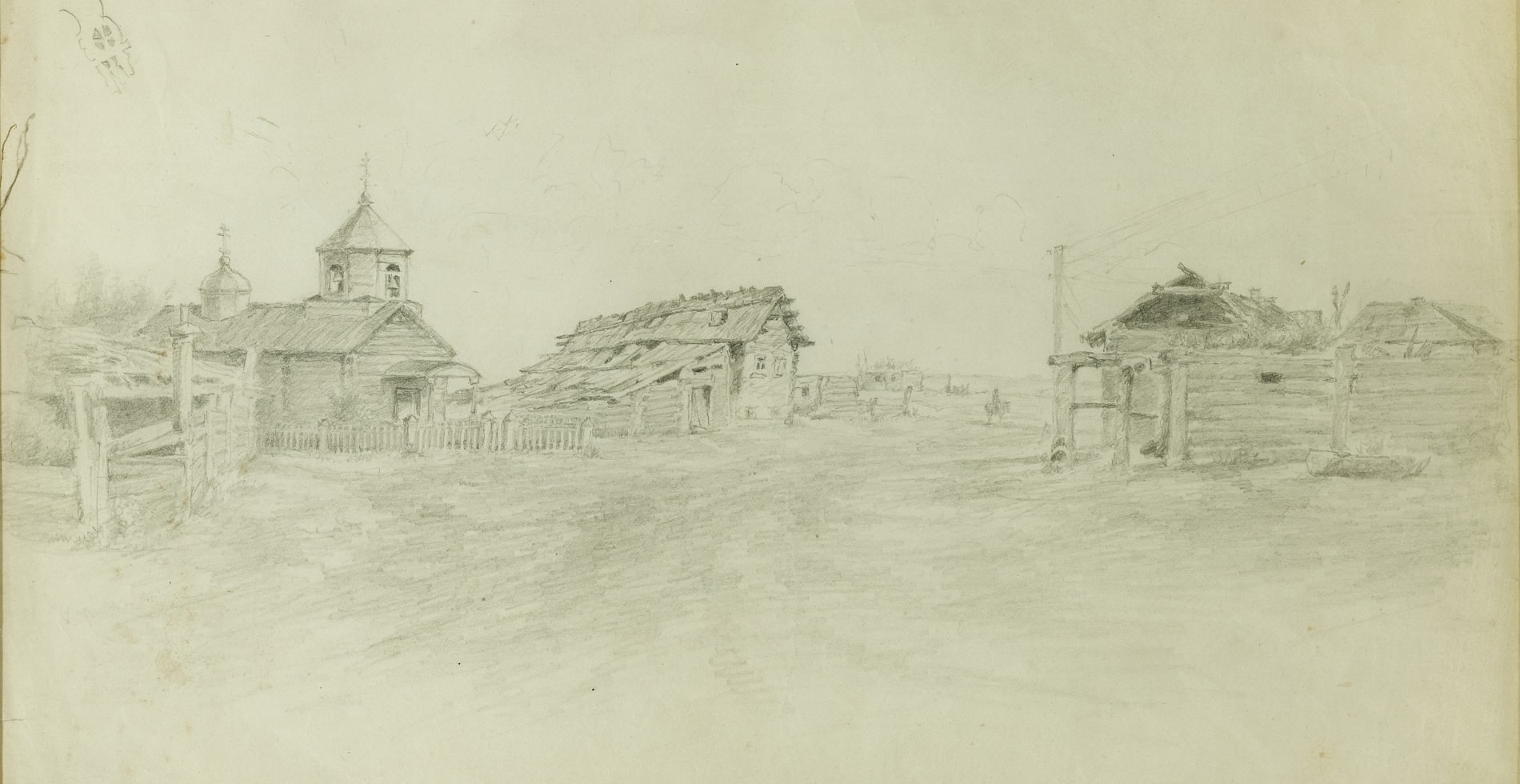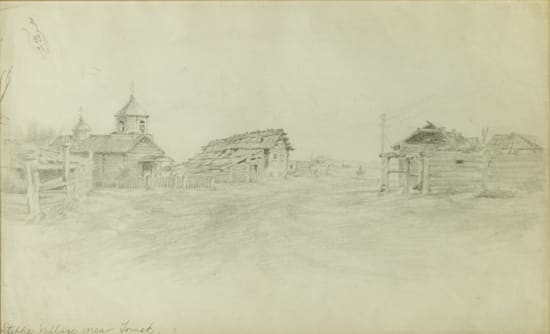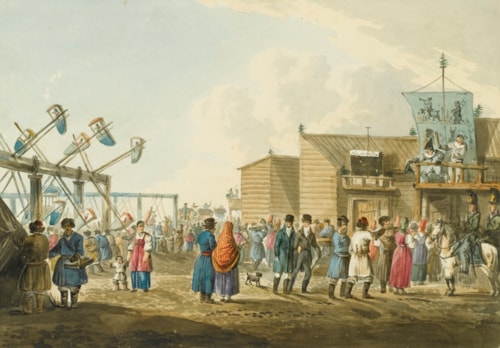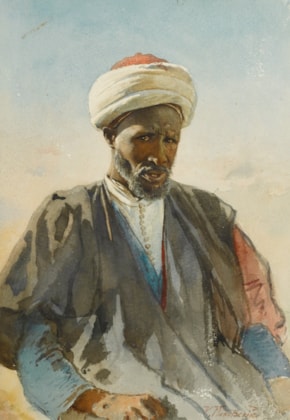eorge Albert Frost
(Boston, Massachusetts 1843 - Cambridge, Massachusetts 1907)
Six Scenes from Siberian Villages
the first bears the inscription ‘Deep Snow - Russian Village near Tomsk’ (lower left) and a collector’s mark ‘XII/no 10’ lower right;
the second bears the inscription ‘Steppe Village near Tomsk’ (lower left);
the third bears the inscription ‘View in Tomsk’ (lower left) and a collector’s mark ‘6”a/no 15’ (lower right);
the fourth bears the inscription ‘Tartar Street Cemapolatinsk’;
the fifth bears the inscription ‘street in Minusinsk’
pencil on paper
the largest 25.5 cm x 36.2 cm (10 x 14¼ in); the smallest 20.8 x 34.8 cm (8⅛ x 13¾) (6)
This series of six drawings provide a delicate and varied view of the Siberian landscape. George Albert Frost demonstrates outstanding technical ability and his attention to detail and lightness of touch imbue these drawings with serenity and charm without over-romanticising the subject matter.
The six drawings; A Street in Minusinsk, View in Tomsk, Tartar Street Semipalatinsk, Tyumen, the Tura River, A Steppe Village in Tomsk and Deep Snows, Russian Village near Tomsk are likely to have been created during Frost’s second trip to Siberia. In 1885, Frost accompanied American journalist, author and explorer George Kennan (1845-1924) to Siberia to record the lives of exiles. Frost travelled through a wide range of locations and drew several Siberian landscapes. His drawings and photographs were used extensively to accompany Kennan’s book, Siberia and the Exile System. Although not all were used in Kennan’s work, A Street in Minusinsk, and Tartar Street Semipalatinsk match almost mark for mark. A Street in Minusinsk even displays the same sledges and weary townsfolk trudging through the snow.
These drawings embody the bleak Siberian landscape; winding rivers, small villages and snow-covered plains are typical sights that Frost would have encountered on his travels. Frost represents the Siberian landscape in a purely literal manner without any idealised view. He is considered to be part of the ‘White Mountain Art Group’, who in the mid-nineteenth century changed their style placing less emphasis on sublime representation and more on fact. Frost’s painting is almost photographic in its quality and consequently his style of drawing replicates this. However the preliminary drawings from Siberia and the Exile System are lighter in approach compared to the final illustrations seen in the books. Whilst they capture the essence of the scenes with immaculate detail, they are unfinished, works in progress. They are part of a thought process, displaying maker’s marks and labelling, and possess a very human empathy.
Many American writers like Kennan dreamed of American-style economic development in Siberia and began to take exploratory trips across Russia. Over the course of four centuries, Siberia became legendary as a land of involuntary exile and imprisonment. Waves of forced migration populated the territory east of the Urals, giving Siberia its unique history. Together with those compelled to move there, other groups, including missionaries, peasants, and religious nonconformists, found opportunity for a new life on the furthest borders of the Tsarist state.
Frost was born 23rd December 1843 in Boston, Massachusetts, and went on to become a prominent landscape artist in the nineteenth century. He spent his early career in North Cambridge, Massachusetts, where he kept a studio, however he did travel to Europe where he studied under Nicolas de Keyser at the Académie Royale de Belgique in Antwerp. Frost made two trips to Siberia, the first in 1867 was as a member of the British Columbia Exploring Expedition, with the purpose of selecting a route to connect a telephone line from San Francisco to Moscow (Russian-American telegraph). The results of his second trip with Kennan, in 1885, are evident in the present works. Frost died 13th November 1907.
This series of six drawings provide a delicate and varied view of the Siberian landscape. George Albert Frost demonstrates outstanding technical ability and his attention to detail and lightness of touch imbue these drawings with serenity and charm without over-romanticising the subject matter.
The six drawings; A Street in Minusinsk, View in Tomsk, Tartar Street Semipalatinsk, Tyumen, the Tura River, A Steppe Village in Tomsk and Deep Snows, Russian Village near Tomsk are likely to have been created during Frost’s second trip to Siberia. In 1885, Frost accompanied American journalist, author and explorer George Kennan (1845-1924) to Siberia to record the lives of exiles. Frost travelled through a wide range of locations and drew several Siberian landscapes. His drawings and photographs were used extensively to accompany Kennan’s book, Siberia and the Exile System. Although not all were used in Kennan’s work, A Street in Minusinsk, and Tartar Street Semipalatinsk match almost mark for mark. A Street in Minusinsk even displays the same sledges and weary townsfolk trudging through the snow.
These drawings embody the bleak Siberian landscape; winding rivers, small villages and snow-covered plains are typical sights that Frost would have encountered on his travels. Frost represents the Siberian landscape in a purely literal manner without any idealised view. He is considered to be part of the ‘White Mountain Art Group’, who in the mid-nineteenth century changed their style placing less emphasis on sublime representation and more on fact. Frost’s painting is almost photographic in its quality and consequently his style of drawing replicates this. However the preliminary drawings from Siberia and the Exile System are lighter in approach compared to the final illustrations seen in the books. Whilst they capture the essence of the scenes with immaculate detail, they are unfinished, works in progress. They are part of a thought process, displaying maker’s marks and labelling, and possess a very human empathy.
Many American writers like Kennan dreamed of American-style economic development in Siberia and began to take exploratory trips across Russia. Over the course of four centuries, Siberia became legendary as a land of involuntary exile and imprisonment. Waves of forced migration populated the territory east of the Urals, giving Siberia its unique history. Together with those compelled to move there, other groups, including missionaries, peasants, and religious nonconformists, found opportunity for a new life on the furthest borders of the Tsarist state.
Frost was born 23rd December 1843 in Boston, Massachusetts, and went on to become a prominent landscape artist in the nineteenth century. He spent his early career in North Cambridge, Massachusetts, where he kept a studio, however he did travel to Europe where he studied under Nicolas de Keyser at the Académie Royale de Belgique in Antwerp. Frost made two trips to Siberia, the first in 1867 was as a member of the British Columbia Exploring Expedition, with the purpose of selecting a route to connect a telephone line from San Francisco to Moscow (Russian-American telegraph). The results of his second trip with Kennan, in 1885, are evident in the present works. Frost died 13th November 1907.





 contact
contact contact
contact +44 20 7313 8040
+44 20 7313 8040









